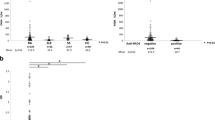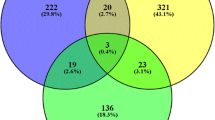Abstract
Analysis of IgG subclass distribution of antibodies may provide insights into the mechanisms driving antibody production. Here, we have first determined IgG subclass distribution of anti-recombinant peptidylarginine deiminase 4 (anti-hPADI4) antibodies in sera from patients with rheumatoid arthritis (RA). Sera from 103 RA patients were screened to IgG anti-PADI4 using recombinant antigens. For positive samples, the subclass distribution of IgG anti-hPADI4 was determined by means of establishing the equipotency of four HRP-labeled IgG subclass-specific monoclonal antibodies. The subclass profiles were compared among individuals with different disease status. Thirty-three out of 103 RA patients were determined as IgG anti-hPADI4-positive. As expressed by percentage levels to total IgG anti-hPADI4 activity, IgG1 and IgG3 were determined to be the predominant subclasses of anti-hPADI4. Furthermore, distinct subclass distribution patterns were observed in patients with different disease status. The IgG subclass distribution of anti-hPADI4 indicates that a leading T lymphocyte-regulated IgG1 and IgG3 responses may contribute to a better understanding of the role of anti-PADI4 in RA.




Similar content being viewed by others
Abbreviations
- Fc:
-
Crystallized fragment
- RA:
-
Rheumatoid arthritis
- PADI4:
-
Peptidylarginine deiminase 4
- IgG:
-
Immunoglobulin G
- ACPA:
-
Anti-citrullinated protein autoantibodies
- anti-hPADI4:
-
Autoantibodies against recombinant PADI4
- DAS28:
-
Disease active score in 28 swollen and 28 tender joints
- DMARDs:
-
Disease-modifying anti-rheumatic drugs
- SLE:
-
Systemic lupus erythematosus
- pSS:
-
Primary Sjögren syndrome
- SSc:
-
Systemic sclerosis
- AU:
-
Arbitrary unit
- HRP:
-
Horseradish peroxidase
- ELISA:
-
Enzyme-linked immunosorbent assay
- PBS:
-
Phosphate-buffered saline
- PBST:
-
PBS with 0.05% Tween-20
- NCS:
-
Newborn calf serum
- RT:
-
Room temperature
- Th1/2:
-
T helper cell 1/2
- Sm:
-
Smith antigen
- U1-RNP:
-
U1 small nuclear ribonucleoprotein
- ADCC:
-
Antibody-dependent cell-mediated cytotoxicity
- RF:
-
Rheumatoid factor
References
Suzuki A, Yamada R, Yamamoto K (2007) Citrullination by peptidylarginine deiminase in rheumatoid arthritis. Ann NY Acad Sci 1108:323–339
Klareskog L, Widhe M, Hermansson M, Rönnelid J (2008) Antibodies to citrullinated proteins in arthritis: pathology and promise. Curr Opin Rheumatol 20:300–305
Takizawa Y, Sawada T, Suzuki A, Yamada R, Inoue T, Yamamoto K (2005) Peptidylarginine deiminase 4 (PADI4) identified as a conformation-dependent autoantigen in rheumatoid arthritis. Scand J Rheumatol 34:212–215
Halvorsen EH, Pollmann S, Gilboe IM, van der Heijde D, Landewé R, Ødegård S, Kvien TK, Molberg Ø (2008) Serum IgG antibodies to peptidylarginine deiminase 4 in rheumatoid arthritis and associations with disease severity. Ann Rheum Dis 67:414–417
Halvorsen EH, Haavardsholm EA, Pollmann S, Boonen A, van der Heijde D, Kvien TK, Molberg Ø (2009) Serum IgG antibodies to peptidylarginine deiminase 4 predict radiographic progression in patients with rheumatoid arthritis treated with tumour necrosis factor-alpha blocking agents. Ann Rheum Dis 68:249–252
Zhao J, Zhao Y, He J, Jia R, Li Z (2008) Prevalence and significance of anti-peptidylarginine deiminase 4 antibodies in rheumatoid arthritis. J Rheumatol 35:969–974
Harris ML, Darrah E, Lam GK et al (2008) Association of autoimmunity to peptidyl arginine deiminase type 4 with genotype and disease severity in rheumatoid arthritis. Arthritis Rheum 58:1958–1967
Auger I, Balandraud N, Rak J, Lambert N, Martin M, Roudier J (2009) New autoantigens in rheumatoid arthritis (RA): screening 8268 protein arrays with sera from patients with RA. Ann Rheum Dis 68:591–594
Arnett FC, Edworthy SM, Bloch DA (1988) The American Rheumatism Association 1987 revised criteria for the classification of rheumatoid arthritis. Arthritis Rheum 31:315–324
van Gestel AM, Haagsma CJ, van Riel PL (1998) Validation of rheumatoid arthritis improvement criteria that include simplified joint counts. Arthritis Rheum 41:1845–1850
Fransen J, Creemers MC, Van Riel PL (2004) Remission in rheumatoid arthritis: agreement of the disease activity score (DAS28) with the ARA preliminary remission criteria. Rheumatol Oxf 43:1252–1255
Samarkos M, Davies KA, Gordon C, Walport MJ, Loizou S (2001) IgG subclass distribution of antibodies against beta(2)-GP1 and cardiolipin in patients with systemic lupus erythematosus and primary antiphospholipid syndrome, and their clinical associations. Rheumatology Oxf 40:1026–1032
Hamilton RG (1987) Human IgG subclass measurements in the clinical laboratory. Clin Chem 33:1707–1725
Rubin RL, Tang FL, Chan EK, Pollard KM, Tsay G, Tan EM (1986) IgG subclasses of autoantibodies in systemic lupus erythematosus, Sjogren’s syndrome, and drug-induced autoimmunity. J Immunol 137:2528–2534
Tokano Y, Yasuma M, Harada S, Takasaki Y, Hashimoto H, Okumura K, Hirose S (1991) Clinical significance of IgG subclasses of Anti-Sm and U1 ribonucleoprotein antibodies in patients with systemic lupus erythematosus and mixed connective tissue disease. J Clin Immunol 11:317–325
Koga M, Yuki N, Hirata K, Morimatsu M, Mori M, Kuwabara S (2003) Anti-GM1 antibody IgG subclass: a clinical recovery predictor in Guillain–Barré syndrome. Neurology 60:1514–1518
de Haan S, Lahooti H, Morris O, Wall JR (2010) Epitopes, immunoglobulin classes and immunoglobulin G subclasses of calsequestrin antibodies in patients with thyroid eye disease. Autoimmunity. doi:10.3109/08916931003774954
Chang X, Yamada R, Suzuki A, Sawada T, Yoshino S, Tokuhiro S, Yamamoto K (2005) Localization of peptidylarginine deiminase 4 (PADI4) and citrullinated protein in synovial tissue of rheumatoid arthritis. Rheumatol Oxf 44:40–50
Foulquier C, Sebbag M, Clavel C et al (2007) Peptidyl arginine deiminase type 2 (PAD-2) and PAD-4 but not PAD-1, PAD-3, and PAD-6 are expressed in rheumatoid arthritis synovium in close association with tissue inflammation. Arthritis Rheum 56:3541–3553
Spiegelberg HL (1989) Biological role of different antibody classes. Int Arch Allergy Appl Immunol 90(Suppl 1):22–27
Firestein GS (2003) Evolving concepts of rheumatoid arthritis. Nature 423:356–361
Cohen PL, Cheek RL, Hadler JA, Yount WJ, Eisenberg RA (1987) The subclass distribution of human IgG rheumatoid factor. J Immunol 139:1466–1471
Chapuy-Regaud S, Nogueira L, Clavel C, Sebbag M, Vincent C, Serre G (2005) IgG subclass distribution of the rheumatoid arthritis-specific autoantibodies to citrullinated fibrin. Clin Exp Immunol 139:542–550
Engelmann R, Brandt J, Eggert M, Karberg K, Krause A, Neeck G, Mueller-Hilke B (2008) IgG1 and IgG4 are the predominant subclasses among auto-antibodies against two citrullinated antigens in RA. Rheumatol Oxf 47:1489–1492
Acknowledgements
We thank Akari Suzuki (Laboratory for Rheumatic Diseases, SNP Research Centre, Institute of Physical and Chemical Research, Kanagawa, Japan) for offering the PADI4 expression vector.
Funding
The current study did not receive any external funding.
Disclosures
None.
Author information
Authors and Affiliations
Corresponding author
Rights and permissions
About this article
Cite this article
Wang, W., Li, J. Predominance of IgG1 and IgG3 subclasses of autoantibodies to peptidylarginine deiminase 4 in rheumatoid arthritis. Clin Rheumatol 30, 563–567 (2011). https://doi.org/10.1007/s10067-010-1671-4
Received:
Revised:
Accepted:
Published:
Issue Date:
DOI: https://doi.org/10.1007/s10067-010-1671-4




